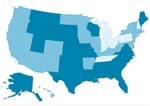Profession
"Choking game" needs to be on physicians' radar
■ Bruises around the neck, unexplained headaches and bloodshot eyes are common signs that a young patient may be playing the risky game.
By Tanya Albert Henry — Posted Dec. 29, 2009
- WITH THIS STORY:
- » Related content
Pediatricians and family physicians need to be aware of the signs of an increasingly common, life-threatening adolescent activity called the "choking game" so they can give patients and their parents guidance about its dangers, a new study says.
Of 163 pediatricians and family physicians surveyed in December 2007, 68% had heard of the game. But 61% of those doctors knew of it through popular media, not medical training or literature, according to a study published online Dec. 14 in the journal Pediatrics (link).
In the choking game -- also called the pass-out game, fainting game and blackout game -- participants try to get a euphoric feeling by temporarily depriving the brain of oxygen. Children and young adults, generally age 7 to 21, let another person use his or her hands to apply pressure to the neck to cut off oxygen.
They also may use belts, neckties or other methods to achieve the high. In some cases, a participant takes a deep breath and holds it while someone else hugs from behind until the recipient feels dizzy and passes out.
Pediatric neurologist Nancy E. Bass, MD, a study author, hopes to see more medical education on the topic, especially for pediatricians, family physicians and emergency physicians, who are those most likely to encounter patients involved in the behavior.
"We can then be aware of it and can choose what to do about it," said Dr. Bass, who practices at Rainbow Babies and Children's Hospital in Cleveland and is an associate professor of pediatric neurology at Case Western Reserve University School of Medicine.
Risky behavior by teens
Advocacy groups have identified more than 100 parent-reported deaths from the game per year between 2005 and 2007, according to the study. A recent Centers for Disease Control and Prevention report analyzed media accounts and estimated 82 probable choking-game-related deaths from 1995 to 2007. Studies have shown injuries such as seizures, headaches, fractures and brain damage, ranging from subtle cognitive impairment to persistent vegetative state.
"The full extent of the injuries and deaths caused by the choking game is likely underrepresented by these accounts because many of the cases are never reported or may be classified as suicides," the report stated.
Physicians who heard of the game could identify only about three of 11 warning signs, the study reported. The most common included bruising or red marks around the neck and bloodshot eyes and/or petechiae on the face. Among other signs: curiosity about asphyxiation; frequent, often severe, headaches; wear marks on furniture such as bunk beds or closet rods; unusual demands for privacy; and locked or blocked bathroom doors.
The study found only 2% of doctors aware of the game reported that they included the topic in routine discussions with adolescents. However, 65% of all physicians surveyed said the topic should be discussed.
"Overall, we hope this is a sparking point for physicians to know that this is out there and that even in a busy practice you can look for the signs and discuss it with patients," said Julie L. McClave, MD, a study author and pediatric resident at Rainbow Babies and Children's Hospital.
Among physicians aware of the game, 7% had cared for a patient they suspected of participating. But chances are that doctors have more of these patients than they realize, the study said, noting a survey of adolescents in Williams County, Ohio, found 11% admitted to playing the game.
Dr. Bass, who has treated choking game patients rushed to the emergency department, now includes questions about the behavior during office visits. "I changed my own practice based on this study."
She hopes the study's findings change other physicians' approach as well, or at least arm them with the knowledge to recognize the warning signs that kids and teens are playing the game and prompt them to ask all their adolescent patients about it.












